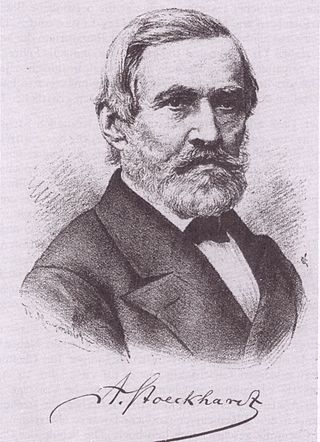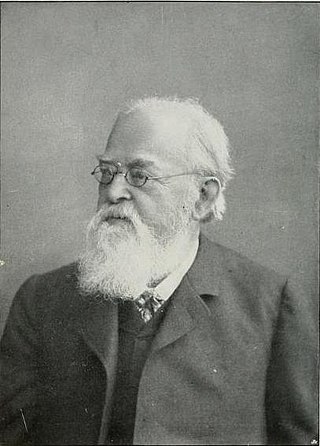Related Research Articles

Agricultural science is a broad multidisciplinary field of biology that encompasses the parts of exact, natural, economic and social sciences that are used in the practice and understanding of agriculture. Professionals of the agricultural science are called agricultural scientists or agriculturists.

Justus Freiherr von Liebig was a German scientist who made major contributions to agricultural and biological chemistry, and is considered one of the principal founders of organic chemistry. As a professor at the University of Giessen, he devised the modern laboratory-oriented teaching method, and for such innovations, he is regarded as one of the greatest chemistry teachers of all time. He has been described as the "father of the fertilizer industry" for his emphasis on nitrogen and trace minerals as essential plant nutrients, and his popularization of the law of the minimum, which described how plant growth relied on the scarcest nutrient resource, rather than the total amount of resources available. He also developed a manufacturing process for beef extracts, and with his consent a company, called Liebig Extract of Meat Company, was founded to exploit the concept; it later introduced the Oxo brand beef bouillon cube. He popularized an earlier invention for condensing vapors, which came to be known as the Liebig condenser.

Rothamsted Research, previously known as the Rothamsted Experimental Station and then the Institute of Arable Crops Research, is one of the oldest agricultural research institutions in the world, having been founded in 1843. It is located at Harpenden in the English county of Hertfordshire and is a registered charity under English law.

Jean-Baptiste Joseph Dieudonné Boussingault was a French chemist who made significant contributions to agricultural science, petroleum science and metallurgy.
The United States National Agricultural Library (NAL) is one of the world's largest agricultural research libraries, and serves as a national library of the United States and as the library of the United States Department of Agriculture. Located in Beltsville, Maryland, it is one of five national libraries of the United States. It is also the coordinator for the Agriculture Network Information Center (AgNIC), a national network of state land-grant institutions and coordinator for the U.S. Department of Agriculture (USDA) field libraries.

The history of agricultural science is a sub-field of the history of agriculture which looks at the scientific advancement of techniques and understanding of agriculture. Early study of organic production in botanical gardens was continued in with agricultural experiment stations in several countries.

Agricultural research in Israel is based on close cooperation and interaction between scientists, consultants, farmers and agriculture-related industries. Israel's climate ranges from Mediterranean (Csa) to semi-arid and arid. Shortage of irrigation water and inadequate precipitation in some parts of the country are major constraints facing Israeli agriculture. Through extensive greenhouses production, vegetables, fruits and flowers are grown for export to the European markets during the winter off-season.

Wilbur Olin Atwater was an American chemist known for his studies of human nutrition and metabolism, and is considered the father of modern nutrition research and education. He is credited with developing the Atwater system, which laid the groundwork for nutrition science in the United States and inspired modern Olympic nutrition.

The Connecticut Agricultural Experiment Station (CAES) is the Connecticut state government's agricultural experiment station, a state government component that engages in scientific research and public outreach in agriculture and related fields. It is the oldest state experiment station in the United States, having been founded in 1875. Its official mission is to "develop, advance, and disseminate scientific knowledge, improve agricultural productivity and environmental quality, protect plants, and enhance human health and well-being through research for the benefit of Connecticut residents and the nation." The station operates a main research campus in New Haven, a research farm in Hamden, a satellite research facility and farm in Windsor, and a research farm in Griswold. The Storrs Agricultural Experiment Station is a separate agricultural research agency, founded in 1887 and part of the University of Connecticut, which also receives state and federal funding.
The Arkansas Agricultural Experiment Station (AAES) is the statewide research component of the University of Arkansas System's Division of Agriculture. The Division also includes the Cooperative Extension Service. The AAES and CES work together to develop and test new agricultural technology and extend it to the public. Research faculty and staff are based on five university campuses, at five Research and Extension Centers; six research stations and seven specialized units.

Julius Adolph Stöckhardt was a German agricultural chemist. He is mostly recognized for his work on fertilizers, fume damage of plants and his book Die Schule der Chemie, which was translated into 14 languages. His 500 lectures and over 500 publications helped to establish agricultural chemistry in Germany.

The history of fertilizer has largely shaped political, economic, and social circumstances in their traditional uses. Subsequently, there has been a radical reshaping of environmental conditions following the development of chemically synthesized fertilizers.
The University of Maryland College of Agriculture and Natural Resources is the agricultural and environmental sciences college of the University of Maryland and operates the Maryland Sea Grant College in cooperation with the University of Maryland Center for Environmental Science and the National Oceanic and Atmospheric Administration.

Samuel William Johnson was an American agricultural chemist. He promoted the movement to bring the sciences to the aid of American farmers through agricultural experiment stations and education in agricultural science.
The University of Kentucky Martin-Gatton College of Agriculture, Food and Environment is a public agricultural college at the University of Kentucky. The college was renamed the College of Agriculture, Food, and Environment on July 1, 2013. The name change incorporates the college's expanded role that occurred with the merger of the College of Human Environmental Sciences into the College of Agriculture. The college's research, teaching and outreach programs encompass farms, forests, food, fiber, families and communities. On May 25, 2023, the college announced a $100-million gift from late University of Kentucky alum and former trustee Carol Martin “Bill” Gatton. The college subsequently announced it would be renamed the Martin-Gatton College of Agriculture, Food and Environment pending approval from the UK Board of Trustees. As of June 16, 2023, the college is officially renamed the Martin-Gatton College of Agriculture, Food and Environment.

Sterling Brown Hendricks was an American agriculturist notable for his research on the structural aspects of organic and inorganic chemistry, soil chemistry and plant physiology and nutrition.

New Jersey Hall is a historic education building located on the campus of Rutgers University in New Brunswick, New Jersey. Built in 1889 under the leadership of President Merrill Edward Gates, it housed the Agricultural Experiment Station. It was added to the National Register of Historic Places on February 24, 1975, for its significance in agriculture and education.

Karl Heinrich Ritthausen was a German biochemist who identified two amino acids and made other contributions to the science of plant proteins.
Walter-Ulrich Behrens was a German chemist and statistician who co-discovered with Ronald Fisher the Behrens-Fisher problem and the associated Behrens-Fisher distribution.

The TUM School of Life Sciences is a school of the Technical University of Munich, located at its Weihenstephan campus in Freising. It encompasses the life sciences, in particular biology, agricultural science, food technology, landscape architecture, biotechnology, and nutrition.
References
- ↑ "www.BPI.gr - BENAKI PHYTOPATHOLOGICAL INSTITUTE".
- ↑ "About AUI". Archived from the original on 2016-11-03. Retrieved 2018-10-04.
- ↑ "About us".
- ↑ "About Sutton Bridge CSR". Archived from the original on 2013-04-01. Retrieved 2013-01-25.
- ↑ "Land Grant & Sea Grant: The Hatch Act - University of Florida, Institute of Food and Agricultural Sciences". ifas.ufl.edu. Retrieved 2019-11-14.
- ↑ CRS Report for Congress: Agriculture: A Glossary of Terms, Programs, and Laws, 2005 Edition - Order Code 97-905 Archived 2011-02-12 at the Wayback Machine
- 1 2 Pearson, C.H.; Atucha, A. (January 2015). "Agricultural Experiment Stations and Branch Stations in the United States". Journal of Natural Resources and Life Sciences Education. 44: 1–5. doi:10.4195/nse2013.10.0032.
- ↑ US EPA, OSRTI. "BELTSVILLE AGRICULTURAL RESEARCH CENTER (USDA) Site Profile". cumulis.epa.gov. Retrieved 2019-11-14.
- ↑ "Beltsville Agricultural Research Center". Library of Congress. Retrieved 2019-11-14.
- ↑ Research & Public Service. Rps.uvi.edu. Retrieved on 2014-02-12.
- ↑ Finlay, Mark Russell (1992). Science, Practice, and Politics. p. 69.
- 1 2 Finlay, Mark R. (1988). "The German Agricultural Experiment Stations and the Beginnings of American Agricultural Research". Agricultural History. 62 (2): 41–50. JSTOR 3743282.
- ↑ The Country Gentleman. L. Tucker. 1854.
- ↑ William Cumming Rose (1969) Recollections of personalities involved in the early history of American biochemistry, Journal of Chemical Education 46:759 to 63